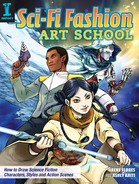Bodies
The best tool for drawing people is a good understanding of how the body works. This section should give you a start, but you can supplement your knowledge with anatomy books, observing from life or movies, and taking figure drawing classes. For more tips on how to draw the human form, check out my books Shojo Fashion Manga Art School and Shojo Fashion Manga Art School: Boys.

MALE-FEMALE COMPARISON
In general, men have wider shoulders and narrower hips. Women have shorter torsos, wider hips and shoulders that slope downward. These aren’t set-in-stone rules, though. Think of them as general guidelines, because bodies come in all shapes and sizes.

BODY TYPES
Not everyone has a perfectly “manly” or “womanly” body. Body types run the whole spectrum, and a lot of them fall in between. Much like different facial features, people can have wide or narrow hips, flat or full chests and long or stocky legs. They can be short, tall, fat or thin.

WHEN IN DOUBT TRY IT OUT
Draw various body types in all sorts of poses, from sitting to walking casually to leaping. Using symmetry guidelines will help keep everything in place. For extra practice, try drawing the same pose from different angles.

RELAXED MUSCLES
After sketching the body’s guidelines, add detail. That doesn’t necessarily mean a lot of muscles, though. For an average body type, this relaxed pose doesn’t have a lot of muscle definition.

MUSCLES IN MOTION
When the body flexes, its muscles contract. Show definition by shading or adding small lines in the places that are more visible due to the light and shadow cast on the skin.

SHOW THEM, DON’T SHOW THEM OFF
You don’t have to pose and flex to show muscle definition. Physical activities automatically put the muscles being used on display.
